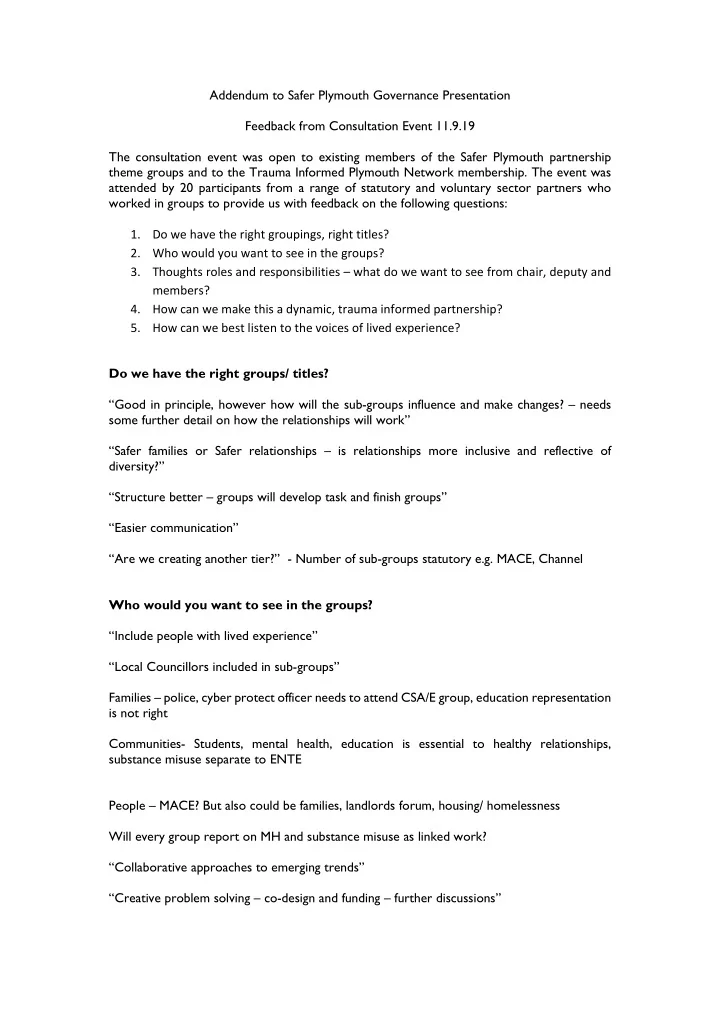

Addendum to Safer Plymouth Governance Presentation Feedback from Consultation Event 11.9.19 The consultation event was open to existing members of the Safer Plymouth partnership theme groups and to the Trauma Informed Plymouth Network membership. The event was attended by 20 participants from a range of statutory and voluntary sector partners who worked in groups to provide us with feedback on the following questions: 1. Do we have the right groupings, right titles? 2. Who would you want to see in the groups? 3. Thoughts roles and responsibilities – what do we want to see from chair, deputy and members? 4. How can we make this a dynamic, trauma informed partnership? 5. How can we best listen to the voices of lived experience? Do we have the right groups/ titles? “Good in principle, however how will the sub-groups influence and make changes? – needs some further detail on how the relationships will work” “Safer families or Safer relationships – is relationships more inclusive and reflective of diversity?” “Structure better – groups will develop task and finish groups” “Easier communication” “Are we creating another tier?” - Number of sub-groups statutory e.g. MACE, Channel Who would you want to see in the groups? “Include people with lived experience” “Local Councillors included in sub-groups” Families – police, cyber protect officer needs to attend CSA/E group, education representation is not right Communities- Students, mental health, education is essential to healthy relationships, substance misuse separate to ENTE People – MACE? But also could be families, landlords forum, housing/ homelessness Will every group report on MH and substance misuse as linked work? “Collaborative approaches to emerging trends” “Creative problem solving – co-design and funding – further discussions”
“Funding and commissioning needs to be in the themes not solely in the exec” “Linking education – TIN education group should make explicit reference to Safer Plymouth and use this to publicise values to all schools – PCC” more solution focused rather than problem/abuse focused in subgroups i.e. safer people – building resilience, aiding recovery safer families – building health relationships safer communities – creating caring communities, challenging inappropriate behaviour Thoughts on roles and responsibilities Key aspect – intelligence analysis and reporting, how will reporting be done? “Right person not necessarily right role, does it always need to be managers or CEO at meetings?” How can we make this a dynamic, trauma informed partnership? “Logo could be everywhere if needed! Can we endorse this, needs a clear message behind it” “Can we use the logo to represent the partnership? This would help with partnership work e.g. drink drive safety at Xmas” “Use of social media/ videos/ podcast to allow practitioners to share their stories for being trauma informed” DA group good example of systems change “How do we get the right message for training key workers/ staff as well as people, families and communities?” Straplines for people/ families/ communities “Engine house for ACE” “Healthy relationships” ‘What are we doing to build i. Resilience, ii. Recovery iii. Strengths based culture? How can we best listen to the voices of lived experience? To encourage participation – show them they have influence, ‘you said, we did’, empowerment, benefit from it demonstrated Need to ask people what they think of trauma informed – everyone veterans, YP, university (#students@saferplymouth, #veterans@saferplymouth) About where people are in their lives
NB: Police work around MH may not be recognised as Safer Plymouth Work! “Listen to the voice of those who want to be heard or need to be heard” Key communication and coordination at operational level ‘You said-We did’ – apps, podcasts, memes, soundbites?
Recommend
More recommend